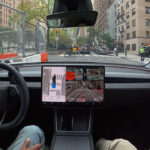Tesla (TSLA) started rolling out the latest version 12.5.6 of its Autopilot Full Self-Driving software earlier this week.
This was a step change for the Tesla S3XY lineup as these vehicles joined the Cybertruck with the “End-to-End on Highway” neural net decision-making with the FSD v12.5.6 update. However, this major update was overshadowed by the Tesla Robotaxi unveiling event on Thursday.
In addition to the End-to-End on Highway, Tesla made other improvements and introduced some new features (listed in the FSD v12.5.6 release notes).
FSD 12.5.6 Driver Profiles
One improved feature was the Updated Driver Profiles. Tesla renamed the 3 available driver profiles to Chill, Standard, and Hurry. The new names FSD driver profiles now make more sense compared to the previous Chill, Average, and Assertive.

We can see that Tesla has introduced a new feature named Max Speed Offset (labeled as ‘new’ on the settings screen in FSD v12.5.6). The release notes of this version named it “Auto Set Speed has been updated to Max Speed” which created some confusion for the Tesla owners.
However, during the ‘We, Robo’ Tesla Robotaxi unveiling event, Tesla influencer and FSD beta tester Chuck Cook got a chance to talk to a Tesla AI engineer Phil Duan who explained it to him for clarity. Chuck wrote on X:
The new profiles in FSD Supervised v12.5.6 called Chill, Standard, and Hurry were further described to me by Phil Duan at the We, Robot event. Currently, these modes are for E2E Highway ONLY (not City Streets) and work in conjunction with the new Max Set Speed.
Chill is essentially the old Minimal Lane Changes and will camp in the slower lanes. Hurry is the old aggressive and will get in the faster lanes and go higher toward the Selected MAX.
There is not a setting any longer to have the car go to the set speed like they had in v11. The speed model still selects the recommended speed that is no faster than the max speed selected.
You can now set the Max Speed Offset from marked speed on highways. Vehicle owners and drivers are now in control of how much Tesla Autopilot is allowed to go above the maximum speed on highways. Users can define it in percentages which is nice since the car has a flexible room within the defined percentage limit.
In the following FSD v12.5.6 first impressions video, Chris (@DirtyTesla) shows us how the max speed offset can be instantly controlled via the scroll wheel on the steering to reduce speed such as in a school zone. Using the right stalk it can be set back to the default you had set via the screen UI.
First Impressions Videos
4-Year-Old Autopilot Visualizations Bug Fixed in FSD 12.5.6 (2024.32.30)
When FSD v12.5.6 users started reporting that the driving visualizations after this update became significantly smoother. Tesla owners first believed that Tesla is now utilizing more processing power to render the visualizations, especially the vehicles around the ego car.
Here’s when the current Tesla Autopilot AI head Ashok Elluswamy joined the conversation and revealed that a 4-year-old bug was fixed in the FSD v12.5.6 which is why the Autopilot visualizations have now dramatically improved.
“Because we fixed a four-year-old bug in the rendering!” posted on X (Twitter).
The previous Director of AI at Tesla Andrej Karpathy replied to Ashok’s statement saying “omg [oh my God]”. To which Ashok replied “yeah”.
Note: FSD v12.5.6 (2024.32.30) still hasn’t gone wide release. Stay tuned for the news and updates.
Stay tuned for constant Tesla updates, follow us on:
Google News | Flipboard | X (Twitter) | WhatsApp Channel | RSS (Feedly).
Related Autopilot / FSD News
- Tesla FSD v14.2.1 conquers ‘The Snake’ highway in California (hairpin turns, ~30 curves, video)
- Tesla FSD v14.2.1 recognizes hand gestures and proceeds a red light and more (videos)
- License Tesla FSD or face the disruption — Musk once again warns legacy automakers
- Tesla offers 30-day FSD v14 trials to HW4 vehicles in North America, FSD v14.2 goes wide release
- Tesla FSD v14.2 modifies how you select Speed Profiles and Arrival Options
- FSD v14.2 parking lot handling tests give mixed results (videos), Tesla expands the rollout circle








